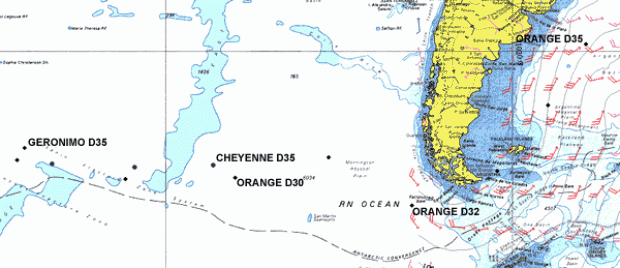Still hurtling north
Monday February 28th 2005, Author: James Boyd, Location: Transoceanic

End of day 35 data (1000GMT)
Position: 39 04.92'S 47 09.28'W
Instant speed/course: 20.10 knots/016deg
Dist. covered in 24h : 544 nm (22.7 knots)
Speed from start : 23.9 kts
DTS: 20071 nm
DTF: 5837.30 nm
Despite their collision with a whale yesterday, Bruno Peyron and the crew of the maxi-catamaran Orange II are continuing on their Jules Verne Trophy record attempt, and appear to have slowed up little.
An assessment of the damage has revealed delamination along 30cm of the leading edge of the port rudder, following the impact when Orange 2 hit a sea creature at full speed, 30 knots, shortly after 1700 GMT last night. “It was a very violent impact, a bit like when you run up on the sand or hit a rock," described skipper Bruno Peyron. "We immediately saw a fin in our wake - probably that of an orca or a whale."
The immediate danger is that the rudder will continue to delaminate further as the water pressure from sailing along at speeds still approaching 30 knots peels it opens up at the front. Yves le Blevec, on board composites specialist is making numerous exchanges with Orange II's builders at the Multiplast yard to come up with a possible repair solution.
Peyron has decided to slow up the pace, while waiting for the outcome of this exchange (although this is not evident from their position updates which show the boat to have been making between 15 and 28 knots overnight). “We’re not forcing the boat along anymore," says Peyron. "We’re sailing with the boat flat so as not to put too much stress on the damaged appendage”.
The rudder on a 120ft long maxi-catamaran like Orange 2 is an enormous piece of composite engineering measuring over 3.50m tall including the rudder stock. Attempting to remove it and then replaced it after attempting a repair, while in the middle of the ocean will be a major operation. The crew would have to stop the boat and tackle it in much the same way as some of the skippers in the Vendee Globe, although it is uncertain whether they have enough ballast on board to attach to the buoyant rudder to pull it out through the bottom of the boat.
“We are ready for anything” continues Peyron. "Our record attempt continues. The key word is vigilance in order to quickly detect any increase in vibration at the helm. We will try to optimise our course more than ever before, by sailing down the most favourable angles to the wind to sail quickly without putting too much strain on the injured rudder."
Orange II is this morning approaching the latitude of the River Plate and yesterday's forecast is continuing to hold true - she is due have strong following winds taking her all the way up to Rio, at present some 980 miles to her north which at her present pace she will pass sometime in the early hours of Wednesday morning. Only then will the wind abate as the team will have to tackle to transistion zone between the southwesterlies and the northeasterly trades. If any major surgery is to be undertaken it will be around this time perhaps even in the calmer waters to the lee of Islas di Trindade 600 miles off the Brazilian coast.
"“The good news is that had we hit something harder like a container, the damage could have been very considerable. We have suffered no structural damage," says Peyron. "Unfortunately the climb up the Atlantic must be made on port tack. Though we must continue to hobble along on this record attempt, our lead is sufficient that we don’t feel it is in danger. It’s the sport that is in danger in the sense that we are no longer able to sail with the intensity we would have wished.”









Latest Comments
Add a comment - Members log in